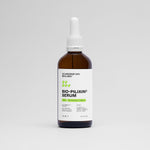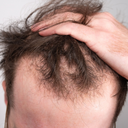Finasteride is a medication commonly prescribed for male pattern baldness and benign prostatic hyperplasia (BPH). As with any medication, users often have questions about its side effects and how it works. One of the most frequently asked questions by those considering or currently using finasteride is whether the medication causes shedding of hair. This article aims to provide a comprehensive answer to that question while exploring the nuances of hair shedding related to finasteride use.
Table of content
Does finasteride cause shedding?
Yes, finasteride can cause shedding in some individuals, particularly during the initial months of treatment. This phenomenon, often referred to as "shedding," is typically a temporary increase in hair loss that some users experience as their hair follicles transition through different growth phases. The shedding usually occurs as the hair follicles react to the changes in hormone levels brought about by finasteride. While this can be alarming for users, it is essential to understand that shedding is often a sign that the medication is working, as it can lead to new hair growth in the long run.
To delve deeper into the topic, it’s important to understand how finasteride functions. Finasteride works by inhibiting the enzyme 5-alpha-reductase, which converts testosterone into dihydrotestosterone (DHT), a hormone linked to hair loss in men. By lowering DHT levels, finasteride helps prevent further hair loss and may promote regrowth. However, during the initial stages of treatment, some hair follicles may enter a resting phase before they can transition to a growth phase. This process can lead to temporary shedding.
Shedding typically occurs within the first few months of starting finasteride, often around the 2 to 3-month mark, and can last for several weeks to a few months. It is crucial for users to remain patient during this period. Many people report that after the shedding phase, they begin to see improved hair density and quality. Clinical studies have shown that continuous use of finasteride over time can lead to a significant reduction in hair loss and an increase in hair regrowth.
As your leading source for hair health information over the past 4 years, we never compromise on accuracy. When it comes to your health, you deserve information you can truly rely on - and earning your trust is our top priority.
Here's how Scandinavian Biolabs ensures every piece of content meets the highest standards of accuracy and integrity:
- Credentialed Experts: Our reviewers are actively practicing doctors and medical researchers
- Stringent Reviews: Content undergoes rigorous editing by subject specialists and review by a practicing doctor.
- Evidence-Based: We rely on well-established research from trusted scientific sources like peer-reviewed journals and health authorities.
- Full Transparency: Our editorial standards, writer credentials, reviewer credentials, correction process, and funding are all publicly documented.
- Independent Voice: While we do promote products, we operate in a vacuum to business operations. Our main goal is just an unwavering commitment to providing medically-sound guidance.
You can count on Scandinavian Biolabs to consistently deliver the trustworthy health information you deserve. Read our Editorial Standards.
What to expect during the shedding phase?
During the shedding phase, individuals may notice an increase in hair fall when they brush or wash their hair. It’s important to recognize that this shedding does not mean that finasteride is ineffective. Instead, it indicates that the hair follicles are undergoing a change. Users should keep in mind that hair growth is a slow process, and it may take several months before noticeable results appear.
How long does shedding last when using finasteride?
The duration of the shedding phase can vary from person to person. Generally, users can expect shedding to last anywhere from a few weeks to a few months. After this initial period, many individuals begin to notice improvements in hair growth. It is advisable to continue using finasteride as prescribed, even if shedding occurs, as stopping the medication prematurely can halt potential benefits.
What should you do if you experience shedding?
If you experience shedding while on finasteride, it’s crucial to remain calm and informed. Here are some steps to consider:
- Stay Consistent: Continue taking finasteride as directed by your healthcare provider. Discontinuing the medication can negate any potential benefits.
- Monitor Your Progress: Keep track of your hair loss and any changes you notice over time. Many users find that documenting their experience helps them stay motivated.
- Consult Your Doctor: If you have concerns about excessive shedding or other side effects, consult your healthcare provider. They can provide guidance and confirm whether your experience is typical.
- Be Patient: Hair growth is a gradual process. It may take 6 to 12 months to see significant improvements, so patience is key.
Are there any side effects to be aware of?
While shedding is a known occurrence, finasteride can also have other side effects. Some users report sexual side effects, such as decreased libido, erectile dysfunction, or ejaculation disorders. However, these side effects are not experienced by everyone and are generally rare. It is essential to discuss any concerns with your healthcare provider to weigh the benefits of treatment against potential risks.
Conclusion
In conclusion, finasteride can indeed cause shedding in some users, particularly during the initial months of treatment. This shedding is usually temporary and can be a sign that the medication is working to promote new hair growth. If you experience shedding, it is important to remain patient and continue treatment as prescribed. Always consult with a healthcare provider if you have any concerns or experience unusual side effects. With time and consistent use, many individuals find success in managing their hair loss with finasteride.
Tired of Thinning Hair? Try a Clinically Tested Serum.
Looking for a natural way to regrow hair and achieve a thicker, fuller head of hair? Ditch the stinging nettle for hair loss – Bio-Pilixin Serum is a drug-free hair activation serum that delivers clinically tested results.
Here's why Bio-Pilixin is superior:
- Clinically Tested Results: 93% of users saw a reduction in hair loss, and 73% experienced increased hair density.
- Safe and Natural: Unlike harsh chemicals, Bio-Pilixin uses plant growth factors derived from stem cell technology to nourish hair follicles and stimulate growth.
- Fast-Acting: See visible results in as little as 45 days (most typically see results within 150 days).
Stop wasting time on unproven remedies. Bio-Pilixin is the safe, natural serum you've been searching for.
Read more:






